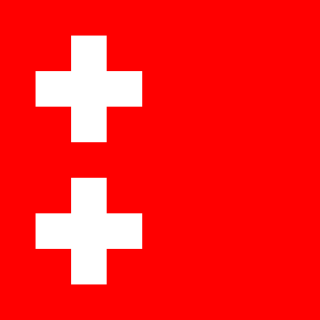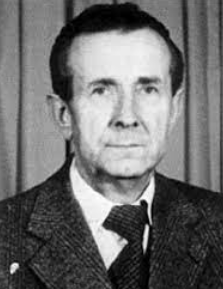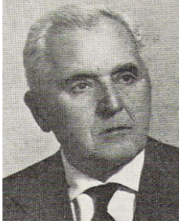The title Grand Duke of Bosnia was a court title in the Kingdom of Bosnia, bestowed by the King to highest military commanders. It was usually reserved for the most influential and capable members of the highest Bosnian nobility. [1] [2] To interpret it as an office rather than merely a court rank could be more accurate. [3]
Vlatko Vuković Kosača was a 14th-century Bosnian nobleman who held the titles of the vojvoda humski and Grand Duke of Bosnia. He distinguished himself as one of the best military commanders of King Tvrtko I in battles against the Ottoman Empire.

The House of Kosača, somewhere Kosačić, was a Bosnian medieval noble family which ruled over parts of modern-day Bosnia and Herzegovina, Croatia, Montenegro, and Serbia between the 14th century and the 15th century. The land they controlled was known as Humska zemlja, roughly corresponding to modern region of Herzegovina, which itself was derived from the title "Herzog", which Stjepan Vukčić Kosača adopted in 1448., with latin title "Dux Sancti Sabbae". Besides Hum, they ruled parts of Dalmatia and Rascia. They were vassals to several states, including the Kingdom of Bosnia and Ottoman Empire. Historians think the Kosača family is part of the Kőszegi family, but there is a lack of evidence for this claim.
The religious confession of the Kosača family is uncertain. They were in contact with the Eastern Orthodox Church, the Church of Bosnia, the Roman Catholic Church and Islam. During the fall of the Bosnian Kingdom, the "Kosače" split into three branches: Venetian, Dalmatian and Ottoman. From then onward, these branches became accepting of the Roman Catholic faith, in the first two cases, and of Islam in the third.

The Duchy of Saint Sava was a late medieval polity in southeastern Europe, that existed from 1448 up to 1482, when it was absorbed by the Ottoman Empire. It was founded and controlled by the Kosača noble family, whose rulers held the title Duke of Saint Sava. Their domains included southern parts of modern-day Bosnia and Herzegovina, extending to southern parts of modern-day coastal Croatia, northwestern Montenegro and southwestern Serbia. Its founder, Stjepan Vukčić Kosača, titled himself Herceg of Saint Sava, a title which would later give rise to the new name to the region: Herzegovina, and will be also used by the Ottomans as Hersek Sancağı, designating the Sanjak of Herzegovina.
Sandalj Hranić Kosača was a powerful Bosnian nobleman whose primary possessions consisted of Hum, land areas between Adriatic coast, the Neretva and the Drina rivers in Bosnia, and served the court as the Grand Duke of Bosnia sometime between 1392 and his death in 1435, although the first mention as a Grand Duke in sources comes from 16 June 1404. He was married three times, but had no children. After his death, he was succeeded by his nephew Stjepan Vukčić Kosača.

Herzegovina is the southern and smaller of two main geographical regions of Bosnia and Herzegovina, the other being Bosnia. It presently does not have strictly defined administrative borders, however in the past it was organized as Sanjak of Herzegovina and Herzegovina Eyalet (1833–1851).

Stjepan Vukčić Kosača (1404–1466) was a powerful Bosnian nobleman who was politically active from 1435 to 1465; the last three decades of Bosnian medieval history. During this period, three kings acceded to the Bosnian throne: Tvrtko II, Thomas (Tomaš), Stephen Tomašević (Stjepan Tomašević) and anti-king Radivoj—the older brother of King Thomas—before the country was conquered by the Ottomans.
Marko Vego was a Bosnian and Yugoslav archaeologist, epigrapher and historian.

The House of Pavlović, also Radinović or Radenović, or Radinović-Pavlović, was Bosnian noble family who got their name after Radin Jablanić. Radin's father, Jablan, was a founder of Jablanić house, an earlier branch of this medieval Bosnian clan. Jablan's estate was in Jablan village. Later, family extended their feudal possessions from the Middle and Upper Drina river in the eastern parts of medieval Bosnia, known as Pavlovića zemlja, to south-southeastern regions of the Bosnian realm in Hum and Konavle at the Adriatic coast. The family official residence and seat was at Borač and later Pavlovac, above the Prača river canyon, between present-day Prača, Rogatica and Goražde in Bosnia and Herzegovina.

Vlachs in medieval Bosnia and Herzegovina were a Western Balkans population descending from a mixture of Romanized pre-Slavic Romance-speaking peoples and the South Slavs. From the 14th century the ethnic meaning of term "Vlach" was replaced with societal meaning and often meant the Slavic population with similar lifestyle. They practiced transhumance as herdsmen, shepherds, farmers, and in time developed peculiar socio-political organizational units known as katuns. With their caravans, Vlach carried out much of the traffic between Bosnian inland and coastal cities such as Dubrovnik. They also had close contacts and militarily served various Bosnian noble families and kings.
Vukmir Zlatonosović was a duke from the noble Zlatonosović family that ruled the area of Usora in the Kingdom of Bosnia.

Dubravko Lovrenović was Bosnian and Herzegovinian medievalist, author and essayist, who worked at the Faculty of Philosophy of the University of Sarajevo, Department of History, in Sarajevo, Bosnia and Herzegovina.

Pavao Anđelić (1920-1985) was a Bosnian Croat and Yugoslav lawyer, archaeologist and historian. He mainly studied the history of medieval Bosnia and is noted for archeological work done at Mile and historically rich areal surrounding modern town of Visoko, as well as Kraljeva Sutjeska and Bobovac.
Esad Kurtović is a Bosnian medievalist and professor at the Faculty of Philosophy of the University of Sarajevo, Department of History, in Sarajevo, Bosnia and Herzegovina.

The Humska Zemlja, also Hum, is a historical zemlja that arose in the Middle Ages as well-defined administrative unit of medieval Bosnia ruled by the Kosača dynasty. It included most of today's Herzegovina, in Bosansko Primorje including Konavle, territories on the south of Dalmatia between Omiš and Neretva Delta, in Boka Kotorska and south to Budva. The name for this zemlja derived from the earlier name for the region, Zahumlje. The seat of Kosače family was in the town and fortress of Blagaj and during the winter seasons, Novi.

Anto Babić was a Bosnian historian, the first dean of the Faculty of Philosophy in Sarajevo, a member of the Academy of Sciences of Bosnia and Herzegovina, SANU, MANU. He was the founder of the Department of History at the Faculty of Philosophy in Sarajevo. He is deemed a doyen of Bosnian and Yugoslav historiography.
Radoslav Pavlović, sometimes spelled Radislav, Radisav or Radosav, was a Bosnian nobleman of the noble family Pavlović-Radinović. He inherited title of knez from his father Pavle Radinović upon his father death, while his older brother Petar (1415–1420), being the first in order of precedence, was bestowed a title of duke by the Bosnian throne. He and his brother also inherited their father's estates in the eastern parts of the Kingdom of Bosnia. After the murder of his father Pavle Radinović on Parena Poljana, near Sutjeska and Bobovac, in 1415 by the hand of Grand Duke of Bosnia, Sandalj Hranić (1392–1435), Radosav together with his older brother Peter, started a war against Sandalj Hranić and his Kosača clan, as those responsible for the murder. After the death of his older brother Petar in the conflict with the Ottomans in 1420, Radosav assumed leadership over the Pavlović's clan and took over the title of duke, and around 1421 he was bestowed a title of Grand Duke of Bosnia by the throne. He ended the conflicts with the Kosača and sealed the peace with a marriage with the daughter of Vukac Hranić, princess Teodora, the sister of the future Kosača's clan chieftain, Stjepan Vukčić (1435–1466), with whom he had three sons. In 1426, he sold his part of Konavle to the Republic of Ragusa for 18,000 perpers, but in 1430 he started the so-called First Konavle War over the sold territories, which ended in 1432 with the recognition of the situation from the beginning of the conflict. In 1435, after the death of Duke Sandalj Hranić, he tried to take advantage of the new situation, but in a conflict with his wife's brother Stjepan, he eventually lost the southern parts of his zemlja around Trebinje. He died in 1441, and was succeeded by his son Ivaniš Radoslavić Pavlović (1441–1450).

Boris Nilević was a Bosnian historian of the middle-ages and early modern era.
Radin Jablanić was a powerful Bosnian nobleman, the oldest known member of the Pavlović noble family and the father of Pavle Radinović, who rose to prominence during the reign of Tvrtko I. His power and wealth made him one of the most powerful magnates and his family one of the most influential in Bosnian Banate and later the Kingdom of Bosnia, ruling the area around between Drina and Vrhbosna, and between Krivaja and Prača.
Petar I Pavlović was a knez, and then a Grand Duke of Bosnia, from the noble family of Pavlović, which had its possessions in the eastern parts of the Kingdom of Bosnia. After the murder of his father Pavle Radinović on Parena Poljana near royal court in Sutjeska and below a Bobovac in 1415, after the stanak at which whole Pavlović family was present at, Petar took over the leadership of the Pavlovići and with his younger brother Knez Radosav (1420–1441) started a war against Sandalj Hranić (1392–1435) and Kosača klan. In that conflict, he relied on the help of the Ottomans, whose help he paid for by recognizing vassal relations to the sultan, which also resulted in successful campaigns against Sandalj, who was completely suppressed. However, the Ottomans changed sides and arrived in the Kingdom of Bosnia in 1420 as Sandalj's allies against Pavlović. In the conflict with them, Petar himself was killed, and his younger brother Radosav succeeds him as the leader of Pavlović and the Grand Duke of Bosnia.

The Pavlovićs' Zemlja,, is a historical zemlja that arose in the Middle Ages as well-defined administrative unit of medieval Bosnia ruled by the Pavlović dynasty. It included most of today's eastern Bosnia, and some territories on the south of the country, around Trebinje, in Bosansko Primorje and in Konavle. The name of Pavlović land is taken from the patronymic, which was borne by two generations of Pavle Radinović's descendants and administrative sub-division term "zemlja". The seat of Pavlović family was in the town and fortress of Borač and later nearby Pavlovac, which were both located on the left bank of the river Prača, between Mesići and Prača.